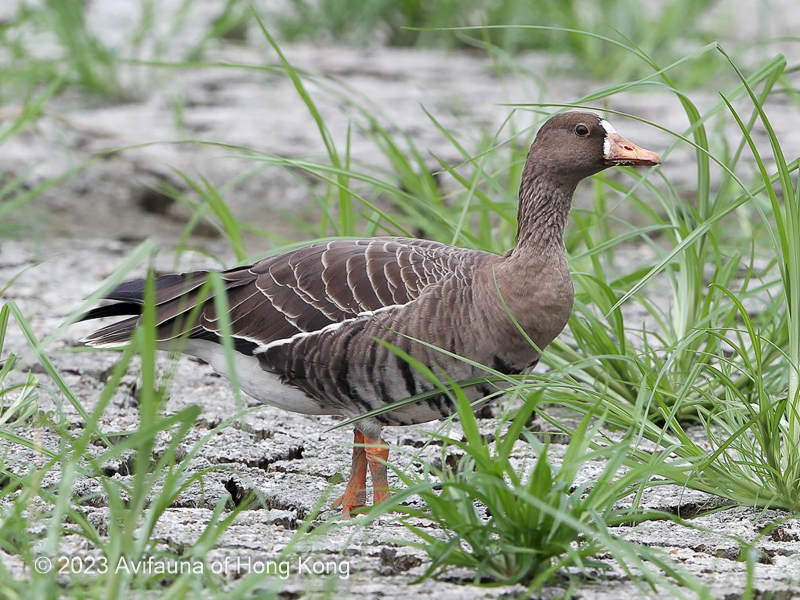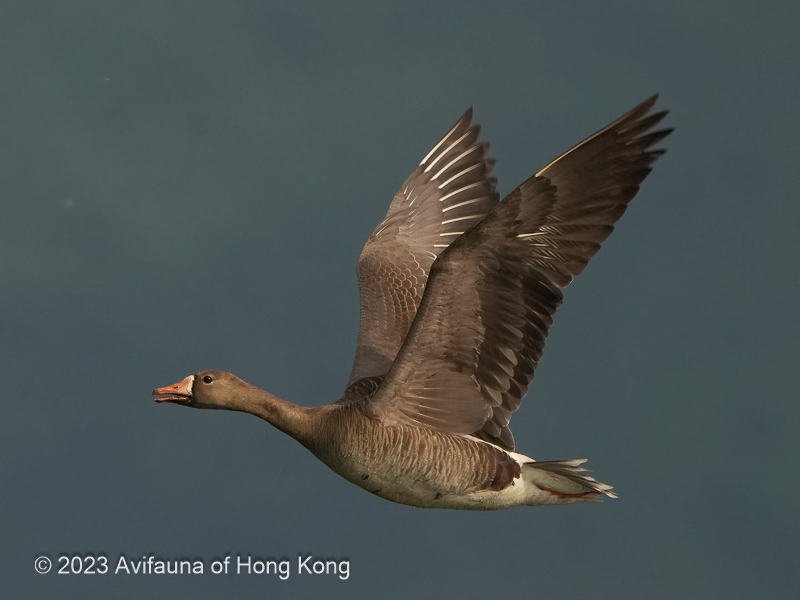Greater White-fronted Goose Anser albifrons 白額雁
Category I. Accidental.
IDENTIFICATION

Oct. 2016, Michelle and Peter Wong. Adult.
66-86 cm. Fairly stocky grey goose with orange legs and relatively square head. Adults have obvious white around base of bill and broad black irregular bars on the belly.

Oct. 2016, Michelle and Peter Wong. Juvenile.
Juvenile bill duller, colour varying from pinkish to orange, no barring on belly, buff fringes to upperparts and little or no white around the bill base. Bill has small but variable amount of dark.

May 2022, Paul Leader. Second calendar year.
In flight has fairly dark upperwing, slightly paler primary coverts and dark barring on belly (adults). This second calendar-year bird has limited white around bill and some barring on underparts.
VOCALISATIONS
Higher-pitched and less nasal than most other grey geese.
DISTRIBUTION & HABITAT PREFERENCE
Most records are from freshwater marsh or fish pond areas in the northwest New Territories.
OCCURRENCE
Extreme dates are 13 October to 21 April.
2004: juvenile at Lok Ma Chau during 8-15 November (Leven 2009).
2005: juvenile at Lok Ma Chau from 2 November to 20 March 2006.
2008: juvenile at Nam Sang Wai on 10 November.
2015: juvenile at Mai Po NR during 27-28 November.
2016: up to four (two adults, two juveniles) at Mai Po NR and San Tin from 13 October to 20 February 2017.
2017: three juveniles at Mai Po NR from 31 October to 12 December, with four on 27 November and 14 December; a juvenile from 31 December to 21 April 2018.
2018: juvenile at Yi O, Lantau on 7 November.
2020: two adults in Deep Bay from 12 November to 15 December, and a juvenile on 11 December.
In addition, one was picked up at Discovery Bay, Lantau on 19 October 1999 and transferred to the Wild Animal Rescue Centre at Kadoorie Farm and Botanic Garden. It was released on 22 November at Mai Po NR, where it remained for much of the winter (Haig 2007). As it was discovered next to the ferry pier and in view of its post-release behaviour at Mai Po, where it remained in what was then a captive waterfowl collection area, it is not regarded as of natural origin.
BEHAVIOUR, FORAGING & DIET
No observations.
RANGE & SYSTEMATICS
Five subspecies are recognised, of which the nominate breeds in north Russia and is presumed to occur in HK. Three subspecies breed in Alaska and Canada, and one in Greenland.
Breeds from northern Russia east through the Arctic zone to northeast Canada and western Greenland; winters from northwest Europe southeast to southwest Asia and east to northern parts of the Indian subcontinent and east Asia (Ely et al. 2020). In China a migrant through the northeast and, rarely, the northwest to wintering areas along the east coast south to Fujian and Taiwan and the middle and lower reaches of the Yangtze floodplain (Liu and Chen 2020).
CONSERVATION STATUS
IUCN: Least Concern. Population trend unknown.
Ely, C. R., A. X. Dzubin, C. Carboneras, G. M. Kirwan, and E. F. J. Garcia (2020). Greater White-fronted Goose (Anser albifrons), version 1.0. In Birds of the World (S. M. Billerman, Editor). Cornell Lab of Ornithology, Ithaca, NY, USA. https://doi.org/10.2173/bow.gwfgoo.01
Haig, A. (2007). Greater White-fronted Goose Anser albifrons at Discovery Bay. An addition to Category E of the Hong Kong List. Hong Kong Bird Report 2001-02: 205-207.
Leven, M. R. (2009). Greater White-fronted Goose Anser albifrons at Lok Ma Chau: the first Category A record for Hong Kong. Hong Kong Bird Report 2003-04: 198-200.
Liu, Y. and Y. H. Chen (eds) (2020). The CNG Field Guide to the Birds of China (in Chinese). Hunan Science and Technology Publication House, Changsha.

